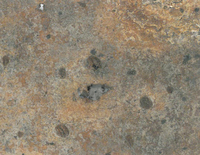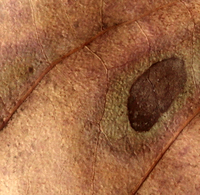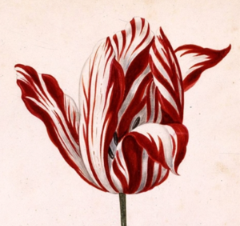Items
Site
The Medicine Chest
keywords is exactly
Ranks Lehloenya
-

Skin
I collected leaves from the gardens around Groote Schuur Hospital and gave them to UCT dermatologist Ranks Lehloenya for analysis. Using the strategy of directing insider focus to an outsider object, Lehloenya treated these specimens as sections of skin and read them accordingly, highlighting sections that showed signs of nummular eczema, acne, ageing, miliary tuberculosis and melanoma, to name a few (Liebenberg 2021: 277). This example was diagnosed as follows: "This section shows characteristics which could point at various causes. The darker raised sections could be blackheads as seen in acne (note the darker central area reminiscent of an open pore); villous hair cysts ( a condition in which hair follicles are trapped under the skin to form pimple-like structures with the hair giving a dark hue in the centre; syringomas (non-cancerous proliferation of sweat glands); infections such as chicken pox or miliary tuberculosis in which the infection spreads from the blood onto the skin (miliary mean it looks like a millet seed). It could also be metastatic melanoma that has spread from another area onto this skin". -

Skin
I collected leaves from the gardens around Groote Schuur Hospital and gave them to UCT dermatologist Ranks Lehloenya for analysis. Using the strategy of directing insider focus to an outsider object, Lehloenya treated these specimens as sections of skin and read them accordingly, highlighting sections that showed signs of nummular eczema, acne, ageing, miliary tuberculosis and melanoma, to name a few (Liebenberg 2021: 277). This example exhibits an annular pattern which could be an infection like a ringworm (fungus) and erythema migrans of Lyme’s disease; or inflammatory conditions like nummular eczema, erythema marginatum as seen in rheumatic fever and granuloma annulare. -

The broken tulip
"During the period known as tulipmania which transpired in the Netherlands during the 17th century, contract prices for bulbs of the recently introduced tulip reached extraordinarily high levels and then suddenly collapsed. Tulips that displayed a break in their colour reached prices far higher than those that didn’t. It wasn’t until 1920, after the invention of the electron microscope, that scientists discovered that the cause for this symphony of colour was a virus that spread from tulip to tulip by Myzus persicae, the peach potato aphid. Michael Pollan in The Botany of Desire, explains this phenomenon: “The colour of a tulip consists of two pigments working in concert — a base colour that is always yellow or white and a second, laid-on colour called an anthocyanin; the mix of these two hues determining the unitary colour we see. The virus works by partially and irregularly suppressing the anthocyanin, thereby allowing a portion of the underlying colour to show through — creating the magic of the broken tulip. A fact that, as soon as it was discovered, doomed the beauty it had made possible" (Pollan 2003: 97 in Liebenberg 2011: 92). -

Semper Augustus Tulip
Photo of Semper Augustus watercolour, captured whilst perusing the Pera Museum, Istanbul, 2013


